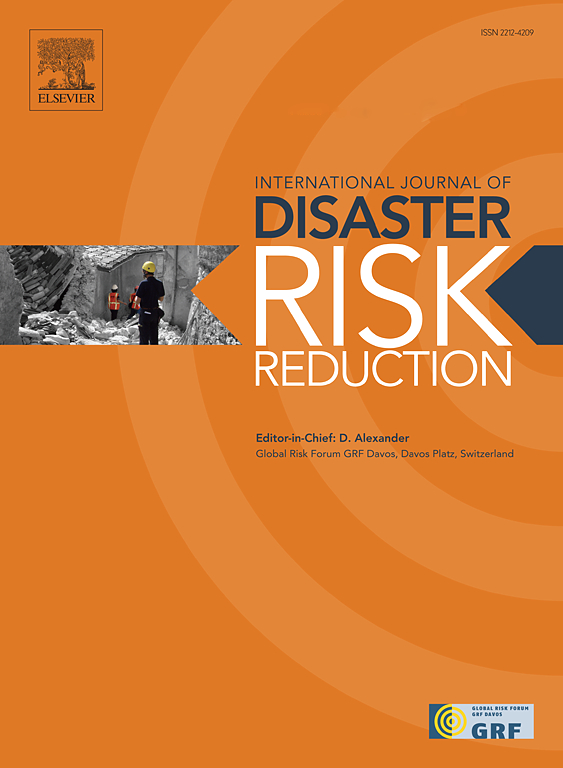合作应对社区野火:加拿大不列颠哥伦比亚省原住民领导力和伙伴关系之路
IF 4.2
1区 地球科学
Q1 GEOSCIENCES, MULTIDISCIPLINARY
International journal of disaster risk reduction
Pub Date : 2024-11-01
DOI:10.1016/j.ijdrr.2024.104933
引用次数: 0
摘要
随着野火规模的不断扩大,许多原住民要求在野火应对中发挥更大的作用。加拿大原住民社区(包括原住民、梅蒂斯人和因纽特人)所受到的不成比例的影响促使他们提出这些要求:尽管约有 5% 的人口自称是原住民,但约 42% 的野火疏散事件发生在原住民占一半以上的社区。在现在的加拿大不列颠哥伦比亚省,原住民和省级机构之间正在出现合作应对野火的新途径。通过对来自原住民社区和机构的 15 位专家进行半结构化访谈,以及对 42 份有关野火应对的文件进行审查,我们的研究强调了现有的各种能力、优先机会以及加强合作途径所需的程序。在原住民社区内,现有能力包括当地知识、灭火经验、设备、资金、关系和领导力--这是一种被忽视的基本能力。优先机会包括在野火响应内外建设能力的方法,例如装备齐全的响应人员、全年全职的野火管理人员、应急管理协调员、原住民联络员以及经过交叉培训的野地和结构性人员。将现有能力转化为优先机会需要持续关注合作过程,包括建立关系、尊重权利和所有权、精简资金以及实现 "文化安全 "以克服种族主义。这些合作途径有助于将野火治理转变为由原住民主导的伙伴关系。本文章由计算机程序翻译,如有差异,请以英文原文为准。
Cooperative community wildfire response: Pathways to First Nations’ leadership and partnership in British Columbia, Canada
With the growing scale of wildfires, many First Nations are demanding a stronger role in wildfire response. Disproportionate impacts on Indigenous communities (including First Nations, Métis, and Inuit) in Canada are motivating these demands: although approximately 5 % of the population identifies as Indigenous, about 42 % of wildfire evacuation events occur communities that are more than half Indigenous. In what is now known as British Columbia, Canada, new pathways for cooperative wildfire response between First Nations and provincial agencies are emerging. Drawing from semi-structured interviews with 15 experts from First Nations communities and agencies, and a review of 42 documents on wildfire response, our research highlights the diverse existing capacities, priority opportunities, and processes required to enhance cooperative pathways. Within First Nations communities, existing capacities include local knowledge, firefighting experience, equipment, funding, relationships, and leadership – an overlooked but fundamental capacity. Priority opportunities include ways to build capacity within and beyond wildfire response, such as fully equipped response crews, full-time year-round wildfire management crews, Emergency Management Coordinators, First Nations Liaisons, and cross-trained wildland and structural crews. Translating existing capacities into priority opportunities requires an ongoing focus on cooperative processes, including relationship-building, respecting Rights and Title, streamlining funding, and enabling “cultural safety” to overcome racism. These cooperative pathways can help transform wildfire governance toward First Nations-led partnerships.
求助全文
通过发布文献求助,成功后即可免费获取论文全文。
去求助
来源期刊

International journal of disaster risk reduction
GEOSCIENCES, MULTIDISCIPLINARYMETEOROLOGY-METEOROLOGY & ATMOSPHERIC SCIENCES
CiteScore
8.70
自引率
18.00%
发文量
688
审稿时长
79 days
期刊介绍:
The International Journal of Disaster Risk Reduction (IJDRR) is the journal for researchers, policymakers and practitioners across diverse disciplines: earth sciences and their implications; environmental sciences; engineering; urban studies; geography; and the social sciences. IJDRR publishes fundamental and applied research, critical reviews, policy papers and case studies with a particular focus on multi-disciplinary research that aims to reduce the impact of natural, technological, social and intentional disasters. IJDRR stimulates exchange of ideas and knowledge transfer on disaster research, mitigation, adaptation, prevention and risk reduction at all geographical scales: local, national and international.
Key topics:-
-multifaceted disaster and cascading disasters
-the development of disaster risk reduction strategies and techniques
-discussion and development of effective warning and educational systems for risk management at all levels
-disasters associated with climate change
-vulnerability analysis and vulnerability trends
-emerging risks
-resilience against disasters.
The journal particularly encourages papers that approach risk from a multi-disciplinary perspective.
 求助内容:
求助内容: 应助结果提醒方式:
应助结果提醒方式:


